From internal pipelines, drains are transported by external ...


Twisted pair refers to cable systems with its own structure, it is used to transmit information in telecommunication networks. Connection to network devices is made by 8Р8С connector. Consider the technical data of twisted pair, taken into account in the formation of computer networks.
The great popularity of using twisted pair is due to the fact that it is combined with different types equipment, easy to install, low cost for networking. Crimping is done with special crimping pliers.
Twisting the wires is made for a specific purpose. The interweaving of wires with a certain weaving step forms a pair of wires with which the quality of communication is improved. Interference from electromagnetic waves have a uniform effect on the wires in a pair, reduce mutual interference during the transmission of signals, external factors during operation.
Twisted pair has various technical data. It depends on the category. It consists of many copper conductors forming a pair. Conductors can be insulated from polyvinyl chloride or polypropylene. High-quality cables are equipped with Teflon insulation or polyethylene. Such insulation provides a guarantee of low dielectric loss, protects the conductors from excessive heat. Conductors may be from one or more cores constituting a bundle.
To make it convenient to cut the cable, a kapron thread for breaking is provided in the shell. The outer shell is made of polyvinyl chloride, as well as flame retardant polymers.
ng (A) - HF; ng (B) - HF; ng is HF; ng (D) - HF;
The outer shell is made of hydrophobic polyethylene. It is applied over a PVC sheath. An empty area in the cable is filled with hydrophobic helium, and can also be equipped with special tape for armoring.
Using different colors, the cable sheath is identified and assigned. The black color indicates that the cable is protected from moisture, the orange cable has resistance to burning. Network cable light gray is used inside offices, residential buildings.
Communication cables are multi-core and single-core, as well as with a shielded sheath and without a screen.
A single-core network cable is used to draw a line in a wall, and does not connect directly to devices. The terminal equipment is connected to the cable, for example, a socket (termination). Such a cable has easily breaking wires.
Twisted-pair cable with several wires is used for switching digital devices. Such a cable is suitable for bends, it has thin veins. A multicore cable has a significant attenuation signal, so its longest length should not be more than 100 m.

UTP - no screen.
Ftp - foil screen.
STP - the screen of each pair and the overall grid.
S / FT - a foil screen for couples and an outer screen.
U / STP - there is no common screen, each pair with a screen.
SF / UTP - two external screens.
The categories of twisted pairs are divided into categories according to the principle of the interval of signal transmission frequency. This is achieved by the number of turns. The higher the transmission frequency and the number of turns, the higher the category.
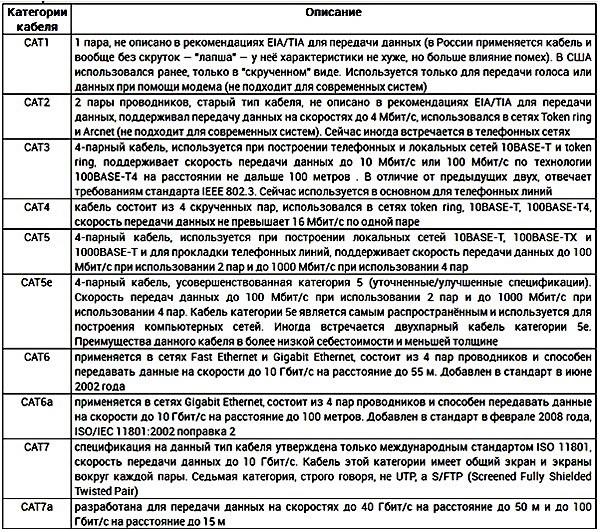
Recently, great progress has been made in science, but many inventions were made back in the 19th century. This can be attributed to twisted pair. Today, such a cable is used widely:
If we compare the coaxial cord and twisted pair, then twisted pair has the best protection of the data stream from interference, due to its structural features. This is especially noticeable at a distance of about 2 kilometers. The signal is clear and clean, especially if a grounded wire with a shield is used. Such a wire is relevant in places with large electromagnetic radiation.
A line can simultaneously transmit several signals: sound, video, telemetry data. There is one limitation: the number of pairs in the cable. To avoid the influence of these pairs on each other in the cable, the twisting steps are made different. The more accurate the balancing, the less the negative impact of the pairs on each other will be lower.
The costs of installing and connecting a local network of computers or video surveillance with different monitors and cameras are reduced, since a shorter cable length is required. If the cable is laid at a distance of more than two kilometers, the signal frequency decays noticeably. Therefore, a network cable is more often used in short networks. It is better to choose a twisted pair cable from copper wires, and not from copper-plated steel.
We will figure out how to compress the twisted pair cable needed to connect computers to each other on a local network, or to connect a TV to a hub, or another media device.
We have the cable, connectors and crimping pliers needed to crimp the twisted pair itself. Consider how two different connectors are crimped. One is two-component, the other is one-component. The two-component connector consists of two parts, has an additional insert, which supposedly makes it easier to assemble the wires in the connector. The one-component connector has no inserts.
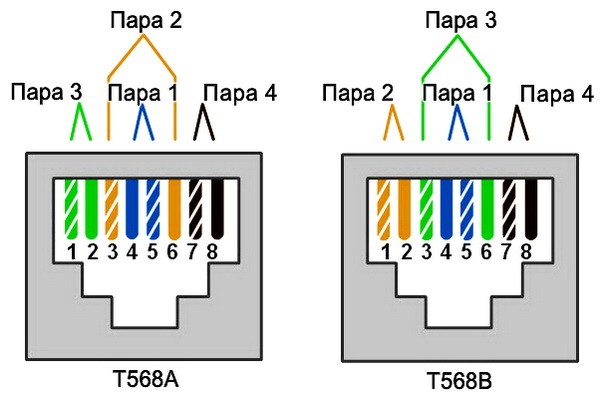
Twisted pair has four twisted pairs of eight conductors. This means that there are eight wires, separated by color. Of these, every two wires are twisted together, thereby they form a twisted pair.
For a home network, a Category 5E cable is suitable. It is designed for indoor installation. There is a cheaper cable option, where instead of eight conductors there are only four wires. That is, the cable has only two twisted pairs.
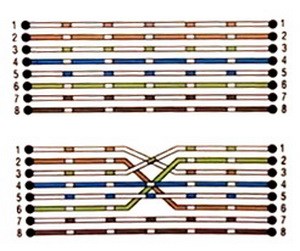
A direct connection is used to connect a computer to the hub, and to connect other devices to the hub. The second is used to connect two computers, or to connect a computer to the hub. It is recommended to crimp the cable according to the second option. If you connect a computer with a hub, then you can connect two computers with the same cable. You do not have to pinch the cable that was crimped by the first option.
The figure shows that some wires cross. This means that on one connector there is one numbering, on the second connector the numbering of the same wires will be completely different.
There are standards for crimping wires by color. For data transmission, only four wires are used. These are 1, 2, 3, and 6 conductors. They are the most important wires. They cross as follows: the first is the third, the second is the sixth. The remaining wires go in parallel.
Consider a connector in the second way. First, we need to cut the end of the wire with pliers. To do this, they have a special knife.
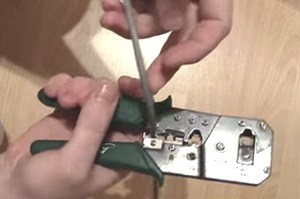
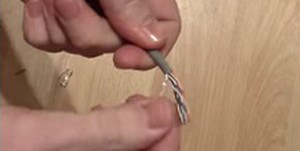
We straighten the wires, and unwind the pairs, straighten the conductors. We distribute them by color, as shown in the figure. We level them so that they fit snugly together.
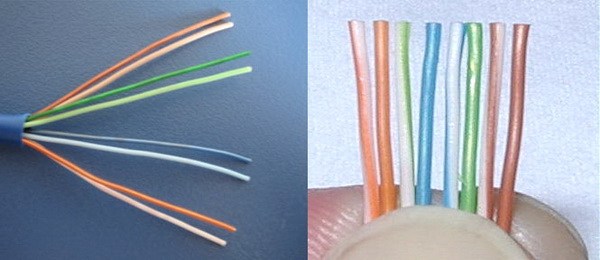
Once again, check the location by color. Now we take crimping pliers and with the knife that is available in them, we cut off conductors 1.5 cm long from the edge of the outer insulation.

After trimming, there is a flat, neat edge. Now take the connector. If you turn the connector to yourself, then the first contact will be located on the right, and the eighth on the left. Now we insert the conductors into the connector. At the same time, we press them to the plane of the comb and to the bottom wall of the connector.
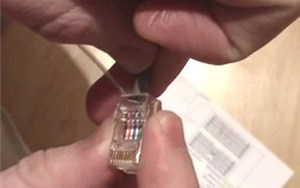
There are special guides, for each wire its own guide channel. Insert until the end. Each posting should shine. This suggests that he rested in a plastic case and inserted to the end.
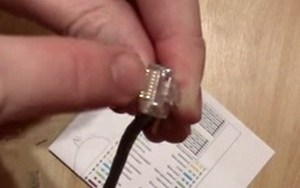
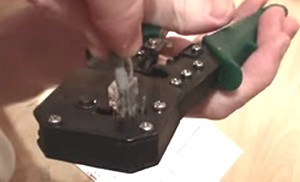
This clamps the comb of contacts on the wires, and on the other hand, the insulation is clamped. This is a properly crimped RJ-45 connector, everything is done correctly. Now it is almost impossible to remove it.
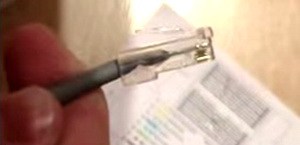
Now consider how a two-piece connector is crimped. We also clean the insulation, straighten the wires, straighten them. If the kapron thread, which is in isolation, interferes, then it can be cut.
The first wire should not be white-orange, but white-green. All wire colors are dialed according to the above scheme. All operations are the same, only different colors. Another difference is to facilitate crimping the contacts, there is a plastic insert. She has a small ledge, which we have up. We cut exactly the wires, insert the wires into this insert.
The peculiarity of this connector is that it is difficult to insert wires into the insert. But it is convenient in that it holds the wire, preserves the order and numbering of the wires. Now, once again, we cut the wires, make a flat edge at a distance of 5 mm from the insert.

Now we also put on the connector, only it is not necessary to press the plastic already.
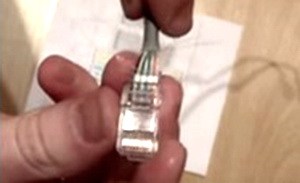
We insert the wires with the insert to the end. Now insert the connector with wires into the crimping pliers and also clamp.
![]()
Our connector is crimped. We got a small patch cord for connecting two computers, or connecting a computer to the hub.
Twisted pair (network cable) Determination of twisted pair cable types, description of the design and categories, crimping schemes, installation. http: //www.site/lan/vitaya-para-setevoi-kabel http: //www.site/@@site-logo/logo.png
Determination of twisted pair cable types, description of the design and categories, crimping schemes, installation.
Content
Twisted pair (twisted pair) - type of communication cable, represents one or more pairs of insulated conductors twisted together (with a small number of turns per unit length), covered with a plastic sheath. The conductors are twisted in order to increase the connection of the conductors of one pair (electromagnetic interference equally affects both wires of the pair) and the subsequent reduction of electromagnetic interference from external sources, as well as mutual interference during the transmission of differential signals. To reduce the connection of individual cable pairs (periodic rapprochement of the conductors of different pairs) in UTP cables of category 5 and above, the wires of the pair are twisted with a different pitch. Twisted pair is one of the components of modern structured cabling systems. It is used in telecommunications and computer networks as a network medium in many technologies, such as Ethernet, ARCNet and Token ring. Currently, due to its low cost and ease of installation, it is the most common solution for building local networks.
The cable connects to network devices using the 8P8C connector (often mistakenly called RJ45 or RJ-45), slightly larger than the RJ11 telephone connector.
Depending on the availability of protection - an electrically grounded copper braid or aluminum foil around twisted pairs, varieties of this technology are determined:
Shielding provides better protection against electromagnetic interference, both external and internal, etc. The screen along the entire length is connected to an uninsulated drain wire, which unites the screen in case of separation into sections in case of excessive bending or stretching of the cable.
Depending on the structure of the conductors - the cable is used single and multicore. In the first case, each wire consists of one copper core, and in the second - from several.
A single-core cable does not imply direct contacts with connected peripherals. That is, as a rule, it is used for laying in boxes, walls, etc., followed by the termination of sockets. This is due to the fact that the copper conductors are quite thick and break quickly with frequent bends. However, for "cutting" into the connectors of the socket panels, such cores are perfectly suited.
In turn, a multicore cable does not tolerate "plunge" into the connectors of the socket panels (thin veins are cut), but it behaves remarkably when bending and twisting. In addition, the stranded wire has a higher signal attenuation. Therefore, a multicore cable is used mainly for the manufacture of patch cords ( patchcord) connecting the periphery to sockets.
A cable usually consists of four pairs. The conductors in pairs are made of monolithic copper wire with a thickness of 0.5-0.65 mm. In addition to the metric, the AWG system is used, in which these values \u200b\u200bare 24 or 22, respectively. The insulation thickness is about 0.2 mm, the material is usually polyvinyl chloride (English abbreviation PVC), for higher-quality samples of category 5 - polypropylene (PP), polyethylene (PE). Especially high-quality cables are insulated with foamed (cellular) polyethylene, which provides low dielectric losses, or Teflon, which provides a high operating temperature range.
Also inside the cable there is a so-called “breaking thread” (usually kapron), which is used to facilitate the cutting of the outer sheath - when pulled, it makes a longitudinal cut on the sheath, which allows access to the cable core, without guaranteeing damage to the insulation of the conductors. Also, a tensile thread, due to its high tensile strength, performs a protective function.
The outer shell has a thickness of 0.5-0.6 mm and is usually made of the usual polyvinyl chloride with the addition of chalk, which increases brittleness. This is necessary for precise breakage at the point of incision with the blade of a cutting tool. In addition, the so-called "young polymers" are beginning to be used, which do not support combustion and do not emit when heating halogens (such cables are marked as LSZH - Low Smoke Zero Halogen and usually have a bright color of the outer shell).
The most common shell color is gray. An orange color usually indicates a non-combustible sheath material that allows lines to be drawn in closed areas. In general, colors do not indicate special properties, but their use makes it easy to distinguish communications with different functional purposes, both during installation and maintenance.
Separately, marking should be noted. In addition to information about the manufacturer and type of cable, it necessarily includes meter or foot tags.
The shape of the outer shell may also be different. More often than others, the simplest one is used - round. Only for laying under the floor, for obvious reason, a flat cable is used.
Cables for outdoor lining they must have a moisture-resistant sheath made of polyethylene, which is applied (as a rule) with a second layer over the usual polyvinyl chloride. In addition, it is possible to fill voids in the cable with water-repellent gel and book using corrugated tape or steel wire.
There are several categories of twisted-pair cable that are numbered from CAT1 to CAT7 and determine the effective transmitted frequency range. A higher category cable usually contains more pairs of wires and each pair has more turns per unit length. Unshielded twisted pair categories are described in the standard. EIA / TIA 568 (American standard for wiring in commercial buildings).
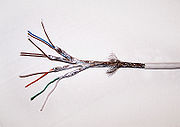 |
| Category 7 twisted pair |
Each twisted pair cable included in the cable intended for data transmission must have a wave impedance of 120 Ohms, otherwise the shape of the electrical signal will be irreversibly distorted and data transmission will become impossible. The reason for this may be not only poor-quality cable, but also the presence of "twists" in the cable and the use of sockets of a lower category than the cable.
These twisted-pair crimping schemes are shown for category 5 cable (4 pairs of conductors). It is crimped by the 8P8C connector.
There are 2 cable crimping schemes: straight cable and crossover cable. The first scheme is used to connect a computer to a switch / hub, the second to connect 2 computers directly and to connect some older models of hubs / switches (uplink port).
EIA / TIA-568A Option:
| 1 | = = = = | = = = = | 1 green and white | |||
| 2 | ==== | ==== | 2 green | |||
| 3 | = = = = | = = = = | 3 orange white | |||
| 4 | ==== | ==== | 4 blue | |||
| 5 | = = = = | = = = = | 5 blue white | |||
| 6 | ==== | ==== | 6 orange | |||
| 7 | = = = = | = = = = | 7 brown white | |||
| 8 | ==== | ==== | 8 brown |
And according to the EIA / TIA-568B standard:
| 1 | = = = = | = = = = | 1 orange white | |||
| 2 | ==== | ==== | 2 orange | |||
| 3 | = = = = | = = = = | 3 green and white | |||
| 4 | ==== | ==== | 4 blue | |||
| 5 | = = = = | = = = = | 5 blue white | |||
| 6 | ==== | ==== | 6 green | |||
| 7 | = = = = | = = = = | 7 brown white | |||
| 8 | ==== | ==== | 8 brown |
Crossover cable for connecting two network cards directly at a speed of 100 Megabits / s (Crossover)
10base-T / 100base-TX crossover (T568B)
Pin No. - core color - Pin No. at the other end of the cable
| 1 | = = = = | = = = = | 1 | |||
| 2 | ==== | ==== | 2 | |||
| 3 | = = = = | = = = = | 3 | |||
| 4 | ==== | ==== | 4 | |||
| 5 | = = = = | = = = = | 5 | |||
| 6 | ==== | ==== | 6 | |||
| 7 | = = = = | = = = = | 7 | |||
| 8 | ==== | ==== | 8 |
Crossover cable for connecting two network cards directly at a speed of 1 Gigabit / s (Crossover)
10base-T / 100base-TX / 1000base-TX / T4 crossover (T568B)
Pin No. - core color - Pin No. at the other end of the cable
| 1 | = = = = | = = = = | 1 | |||
| 2 | ==== | ==== | 2 | |||
| 3 | = = = = | = = = = | 3 | |||
| 4 | ==== | = = = = | 4 | |||
| 5 | = = = = | ==== | 5 | |||
| 6 | ==== | ==== | 6 | |||
| 7 | = = = = | ==== | 7 | |||
| 8 | ==== | = = = = | 8 |
|
|
| Crimp tool (crimper) |
White-orange vein changes from white-green, orange with green (for a 100-megabit connection); the blue core changes from white-brown, white-blue to brown (for a gigabit connection, for 100 megabits they can be crimped in any order or not crimped at all).
The use of a cable that is not crimped according to the standard may lead to the cable not working, or there will be a very large percentage of losses (depending on the cable length), as well as to situations of a complete cable check to determine the purpose of certain pairs.
In order to verify the correct crimping of the cable, in addition to visual inspection, there are special devices - LAN testers. Such a device consists of a transmitter and a receiver. The transmitter alternately sends a signal to each of the eight cores of the cable, duplicating this transmission by lighting one of the eight LEDs, and one of the eight LEDs on the receiver connected to the other end of the line lights up. If the LEDs on the transmission and reception light up in a row, then the cable is crimped without error. More expensive models of LAN testers can have a built-in intercom, a break indicator indicating the distance to the break, etc.
These crimping schemes are suitable for both a 100-megabit connection and a gigabit one. When using a 100 megabit connection, only 2 out of 4 pairs are used, namely orange and green. In this case, blue and brown pairs can be used to connect a second computer via the same cable. Each end of the cable is bisected into two, two pairs, and get, as it were, two cables, but under the same insulation. However, this connection scheme can reduce the speed and quality of information transfer. When using a gigabit connection, 4 pairs of conductors are used.
There are also restrictions on the choice of the cross-connection scheme of conductors imposed by the Power-Over-Ethernet (POE) standard, but this standard has not yet been fully approved. With a direct connection of conductors in a cable ("one to one"), this standard will work automatically.
When installing the cable, the twisted pair must be maintained at the specified curvature in places of bending. Exceeding this may result in reduced resistance to pickups or cable damage.
When installing shielded twisted pairs, you must monitor the integrity of the screen along the entire length of the cable. Stretching or bending leads to the destruction of the screen, which leads to a decrease in resistance to pickups. The drain wire must be connected to the connector screen.
twisted pair crimping for LAN needs on
UTP cable (unshielded twisted pair - unshielded twisted pair) for internal wiring, 2 pairs (solid), category 5, is used in subscriber wiring for providing access to data transmission network services.
|
|
1 - Outer shell
2 - Twisted pair solid
Unshielded 4-pair cable category 5e with solid copper conductors and is designed for use in applications with a bandwidth of up to 1Gb.
|
|
|
1 - Outer shell
2 - Twisted pair solid
| Conductor: | |
| Insulation: | |
| Wire diameter | 0.9 ± 0.02 mm |
| Twisted pair color: | |
| 4 twisted pairs covered with PVC sheath | minimum shell thickness 0.4 mm |
| Cable outer diameter | 5.1 ± 0.2 mm |
| Cable bending radius: | |
| Working temperature: | -20 ° C - + 75 ° C |
| Fire resistance: | CM |
| Standards: |
FTP cable (foiled twisted pair - twisted pair with a common foil screen and copper conductor for the removal of induced currents) for external wiring, 4 pairs (solid), category 5e.
|
|
|
1 - Outer shell
2 - Screen - Foil
3 - Drain wire
4 - Protective film
5 - Twisted pair solid
| Conductor: | bare copper wire Ø0.51 ± 0.01 mm, 24 AWG |
| Insulation: | high density polyethylene, minimum thickness 0.18 mm |
| Wire diameter | 0.9 ± 0.02 mm |
| Twisted pair color: | blue-white / blue, orange-white / orange, green-white / green, brown-white / brown |
| 0.025 mm x 20 mm | |
| Ø0.5 mm | |
| Cable outer diameter | 7.0 ± 0.2mm |
| Cable bending radius: | 8xØ during installation, 6xØ for vertical cabling, 4xØ for horizontal cabling |
| Working temperature: | -40 ° C - + 60 ° C |
| Fire resistance: | CMX |
| Standards: | UL444 / UL1581, TIA / EIA 568B.2. |
FTP cable (foiled twisted pair - twisted pair with a common foil screen and a copper conductor for the removal of induced currents) for external installation with a cable, 4 pairs (solid), category 5e.
|
|
|
1 - Outer shell
2 - Screen - Foil
3 - Drain wire
4 - Protective film
5 - Twisted pair solid
6 - Metal cable
| Conductor: | bare copper wire Ø0.51 ± 0.01 mm, 24 AWG |
| Insulation: | high density polyethylene, minimum thickness 0.18 mm |
| Diameter of conductor with sheath: | 0.92 ± 0.02 mm |
| Twisted pair color: | blue-white / blue, orange-white / orange, green-white / green, brown-white / brown |
| 4 twisted pairs shielded with aluminum foil tape in size | 0.025 mm x 20 mm |
| The cable has a drain wire | Ø0.5 mm |
| The cable is sheathed in polyethylene | minimum shell thickness 0.65 mm |
| Cable outer diameter: | 7.0 ± 0.2 mm |
| Carrier Cable: | cink Steel |
| Cable sheath thickness: | 0.6 ± 0.05 mm |
| Cable diameter: | 2.0 ± 0.1 mm |
| Cable bending radius: | 8xØ during installation, 6xØ for vertical cabling, 4xØ for horizontal cabling |
| Working temperature: | -40 ° C - + 60 ° C |
| Fire resistance: | CMX |
| Standards: | UL444 / UL1581, TIA / EIA 568B.2. |
Shielded copper cable, 10 pairs, insulation - high density polyethylene, sheath - polyethylene, resistant to ultraviolet rays. The cable is designed for external installation, category 5e.
A cable for creating data transmission networks with the development of information technology and the Internet has become the most popular product. Computer networks surround us everywhere: at work and at home, in educational institutions and clinics, in shops and banks. Reliability and quality of communication in the network largely depends on the type of cable used.
For example, you decided to save money and between the buildings laid utp 2 or utp 4 cable, designed for indoor use only. As a result, you will get constant network hangs and data loss. At the same time, using an ftp cable of 25 pairs for external wiring is a waste of money if you create a home network for a couple of computers.
Unshielded twisted pair - this is how the name of the cable with the marking from UTP 2 to UTP 10 is decrypted. Most often this type of cable is used to create home and office networks in the room. UTP 2, consisting of two pairs of wires twisted together, will cope with small amounts of data. Cables of categories UTP 4 to UTP 50 pairs of cables are suitable for creating networks with high bandwidth.
The UTP cable consists of several twisted copper pairs with an outer sheath made of PVC.
Usually UTP series cables are used indoors, but there are models for external wiring, for example, UTP PE 25 cable cat 5 pairs.
The disadvantages of the UTP cable, first of all, are its poor protection from external induced currents, which are both on the street and indoors. In this regard, the UTP cable is suitable for use with minor external electromagnetic interference, types of UTP 2 - UTP 10 are laid at relatively short distances between nodes of the data network.
To establish a reliable network, it is better to use 25 pairs instead of a UTP cable - an FTP cable with more protection from interference.
Cable marked FTP, i.e. shielded twisted pair cable, is better protected from the effects of external induced currents and interference in general. FTP cables 4/8/10/16 are labeled with the number of twisted pairs and are equipped with a foil shielding. FTP cable contains in its configuration a drainage copper wire without insulation, connecting disparate sections of the foil damaged during installation or operation.
A greater number of twisted pairs in the cable, on the one hand, increases its throughput, but the effect of internal interference is more noticeable. FTP 10 pairs with different round pitch in each pair partially solves this problem. This approach allows to significantly increase the distance between the nodes of various parts of the data network. That is why FTP cable is often used for network communications between buildings. The most popular type of cable for organizing an outdoor network can be called external FTP 5e. A metal cable on certain types of cable FTP 4 and FTP 10 makes it possible to air network without the use of additional suspension systems. The outer plastic sheath of FTP 5e makes it more resistant to ultraviolet radiation.
Even the most high-quality and expensive FTP 4 series 5e cable will quickly become worthless if it is improperly installed or systematic violations of the cable network operation rules are made. The network cable will not withstand a bend to a radius that exceeds a value of more than 8 diameters of the cable itself. Too much bending damages the inner screen of the foil, and this, in turn, will noticeably degrade the quality of the cable and reduce the communication speed within the network.
UTP FTP cable twisted pair types of its variety